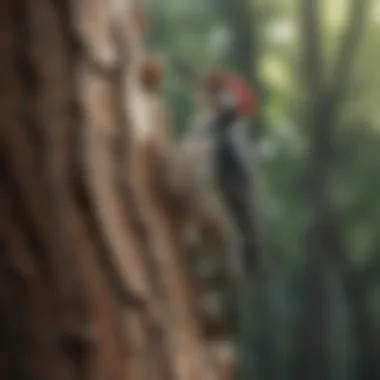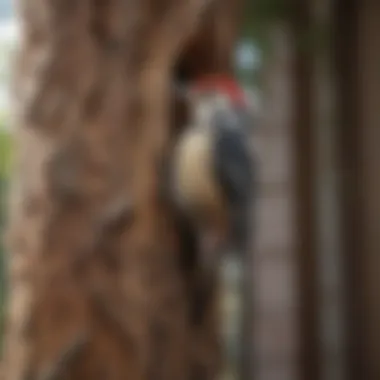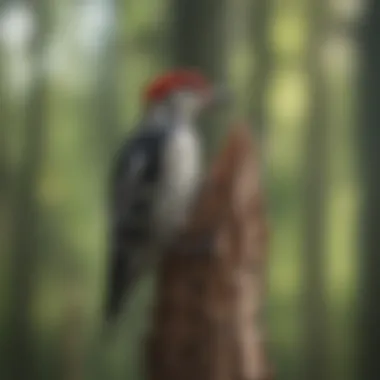Proven Techniques for Deterring Woodpeckers from Damaging Your Home


Animal Species Profile
Woodpeckers are fascinating bird species known for their distinctive drumming sounds and hammering beaks. They belong to the Picidae family, characterized by their unique adaptations for chiseling into trees. With striking plumage patterns that vary between species, woodpeckers display a mix of black, white, and bright colors that enable camouflaging within their wooded habitats. These birds are widely distributed across various woodland regions in North America, Europe, Asia, and Africa, displaying diverse behaviors and social interactions.
Control Strategies and Deterrent Techniques
When it comes to repelling woodpeckers from homes, a range of effective strategies can be implemented to prevent damage and nesting. Some key methods include installing visual deterrents like reflective tape or silhouettes of predators, applying taste aversions on affected areas, setting up physical barriers such as netting or wire mesh, and creating loud noises through devices like wind chimes or ultrasonic repellents. It is crucial to combine these techniques thoughtfully to discourage woodpeckers from returning to the property, ensuring a humane and sustainable approach.
Exclusion Measures and Habitat Modification
To effectively deter woodpeckers without causing harm, homeowners can focus on exclusion measures and habitat modifications. By sealing off potential entry points with sturdy materials like metal flashing or wood, blocking access to favored pecking spots around eaves and trim, and altering the habitat to reduce desirability for nesting, individuals can significantly reduce conflicts with these birds. Furthermore, maintaining trees and shrubs in a healthy condition, providing alternative food sources like bird feeders away from the house, and limiting access to insects can help divert woodpeckers from causing damage.
Seeking Professional Assistance and Legal Considerations
In cases where woodpecker infestations persist despite DIY efforts, seeking professional assistance from wildlife control experts or ornithologists may be necessary. These professionals can assess the situation, offer tailored solutions for deterring woodpeckers effectively, and provide insights into local regulations concerning wildlife protection. It is essential to consider legal implications and ethical aspects when addressing woodpecker conflicts, ensuring compliance with laws that safeguard both the birds and the property owners' interests.
Understanding Woodpecker Behavior
Woodpeckers, with their distinct behavior patterns, can often pose a challenge for homeowners. Understanding Woodpecker Behavior is key to effectively repelling them from your property. By delving into the motives behind a woodpecker's actions, homeowners can implement targeted strategies to deter these birds without causing them harm. This section will explore the nuances of woodpecker behavior, offering insights that can guide your approach towards achieving a peaceful coexistence with these fascinating creatures.
Identifying Reasons for Woodpecker Activity
Woodpeckers exhibit various behaviors that may result in damage to your home. By Identifying Reasons for Woodpecker Activity, we can unravel the underlying causes driving their actions.


Search for Insect Infestations
Search for Insect Infestations plays a crucial role in attracting woodpeckers to homes. Their innate ability to detect signs of insect infestations within wooden structures prompts them to peck and probe in search of food. This behavior, though destructive to your property, serves as a natural method for woodpeckers to secure sustenance. Understanding this aspect of their behavior is essential for devising effective repellent strategies.
Territorial Behavior
Woodpeckers are territorial creatures, fiercely defending their nesting sites. Territorial Behavior manifests in aggressive pecking on surfaces as a means of marking their territory and warding off intruders. While this behavior may result in structural damage to homes, it sheds light on the protective instincts deeply ingrained in woodpeckers. Recognizing and addressing this behavior is pivotal in preventing recurring woodpecker incidents.
Attractiveness of House Materials
The choice of house materials can significantly influence woodpecker activity. Certain materials such as cedar or redwood may be more appealing to woodpeckers due to their softness and resonance when pecked. Understanding the Attractiveness of House Materials allows homeowners to select construction materials that are less likely to attract woodpeckers, thus minimizing the risk of property damage. By assessing and altering the allure of house materials, homeowners can proactively deter woodpeckers from targeting their homes.
Implementing Non-Lethal Deterrents
When addressing the issue of woodpecker activity around your house, implementing non-lethal deterrents plays a crucial role in mitigating potential damage. The utilization of non-lethal methods is not only effective in repelling woodpeckers but also ensures the safety and well-being of both the birds and your property. By focusing on non-lethal approaches, you contribute to a harmonious environment while protecting your home from harm. This section will explore various non-lethal deterrent techniques that can be practical and sustainable in deterring woodpeckers from causing damage.
Visual Deterrents
Visual deterrents are pivotal in creating an environment that discourages woodpeckers from targeting your house. By leveraging visual stimuli, you can effectively distract and deter these birds from causing harm. Among the visual deterrent methods, hanging reflective objects stands out as a notable strategy. These objects mimic movements and reflections that disrupt woodpeckers, steering them away from your property. The reflective nature of these objects confuses the birds and dissuades them from pecking at your house. Despite their effectiveness, it's essential to regularly reposition these reflective objects to maintain their efficacy.
Utilizing Decoys
Incorporating decoys as part of your woodpecker deterrent strategy can significantly impact deterring these birds. Decoys mimic predators or other threats in the birds' environment, inducing a sense of danger and prompting them to avoid the area. Utilizing decoys can create a perception of risk for woodpeckers, deterring them from causing damage to your house. However, it's crucial to periodically rotate or adjust the decoys' positions to prevent the birds from acclimating to them.


Installing Windsocks
Installing windsocks can be an innovative approach to repelling woodpeckers from your property. The movement of windsocks in the breeze creates visual disturbances that disorient the birds, discouraging them from pecking holes in your home. Windsocks provide an ever-changing visual deterrent that can effectively deter woodpeckers in a humane manner. However, ensure that the windsock's material is durable and weather-resistant to maintain its functionality over time.
Adopting Habitat Modification Techniques
As an integral part of this comprehensive guide on repelling woodpeckers from houses, adopting habitat modification techniques plays a crucial role in maintaining a woodpecker-free environment. By adjusting the ecosystem around your house, you can effectively discourage woodpeckers from causing damage and nesting on your property. This section delves into specific methods that focus on altering the woodpeckers' habitat to make it less appealing to them. By taking proactive steps to modify the surroundings, you can create a less attractive environment for woodpeckers, thereby reducing the chances of infestation or damage.
Adjusting Food Sources and Nesting Sites
Woodpeckers are often attracted to houses due to the presence of potential food sources and suitable nesting sites. When it comes to adjusting food sources and nesting sites, several key considerations come into play. Understanding the significance of removing insect-infested wood is essential to effectively repel woodpeckers. By eliminating wood infested with insects, you not only remove a food source for woodpeckers but also make your property less hospitable for these birds. Securing food waste is another crucial aspect as it prevents woodpeckers from scavenging for scraps around your house. By properly disposing of food waste, you eliminate a potential attractant for woodpeckers. Finally, placing nesting boxes strategically can provide woodpeckers with alternative nesting sites away from your house, steering them towards more suitable locations. Although nesting boxes can offer woodpeckers shelter, they help in diverting their attention from your property and promoting nesting in designated areas.
Removing Insect-Infested Wood
Removing insect-infested wood plays a pivotal role in deterring woodpeckers. This process involves identifying and eliminating wood that harbors insects, which are a primary food source for woodpeckers. The key characteristic of removing insect-infested wood lies in disrupting the woodpeckers' food supply chain. By eradicating these infestations, you create an environment that is less conducive to woodpecker activity. One of the advantages of this method is its sustainable approach to addressing the root cause of woodpecker attraction, rather than simply addressing surface symptoms. However, a potential disadvantage of removing insect-infested wood is the labor-intensive nature of this task, as it may require thorough inspection and removal of affected wood sections.
Securing Food Waste
Securing food waste involves properly managing and disposing of all food scraps and waste to prevent woodpeckers from foraging around your house. The key characteristic of securing food waste is the elimination of easily accessible food sources that could attract woodpeckers. This method is beneficial as it reduces the likelihood of woodpeckers lingering around your property in search of leftover food. An advantage of securing food waste is its cost-effectiveness and simplicity, as it primarily involves maintaining cleanliness and using secure containers for trash storage. However, a potential disadvantage could be that woodpeckers may still explore the area in the absence of food waste if other attractions, such as insects, remain prevalent.
Placing Nesting Boxes
Placing nesting boxes strategically can help redirect woodpeckers to designated areas for nesting, thus reducing their presence around your house. The key characteristic of placing nesting boxes is providing alternative nesting sites that mimic natural conditions. This method is beneficial as it gives woodpeckers suitable options for nesting while minimizing disruption to your property. The unique feature of nesting boxes lies in their ability to influence woodpecker behavior positively, encouraging them to choose controlled nesting locations over unsuitable areas like your house. An advantage of this approach is the potential long-term impact of guiding woodpeckers towards sustainable nesting practices. However, a possible disadvantage could be the time and effort required to monitor and maintain the nesting boxes to ensure their effectiveness in deterring woodpeckers.


Seeking Professional Assistance
Seeking professional assistance is a critical aspect when dealing with woodpecker-related issues. Woodpeckers possess unique behaviors that may require expert intervention to effectively manage. Professional guidance ensures the safety of both the property and the woodpeckers themselves. By consulting with wildlife experts, individuals gain access to specialized knowledge and tailored solutions that can address woodpecker problems comprehensively.
Consulting Wildlife Experts
Contacting Local Conservation Organizations
Contacting local conservation organizations plays a pivotal role in mitigating woodpecker disturbances. These organizations offer valuable insights into conservation efforts and provide guidance on handling wildlife issues sustainably. Local conservation organizations often collaborate with communities to promote coexistence between humans and woodpeckers, emphasizing the importance of ethical interventions. Their involvement ensures that interventions align with conservation goals while safeguarding the welfare of woodpeckers.
Hiring Licensed Wildlife Control Services
Hiring licensed wildlife control services is a strategic choice for effectively managing woodpecker conflicts. These services boast specialized expertise in wildlife management, offering tailored strategies to address specific woodpecker-related concerns. Licensed professionals employ humane practices compliant with legal standards, ensuring that interventions prioritize the well-being of both the property and the woodpeckers. Their advanced knowledge equips them to implement ethical and effective solutions for long-term woodpecker deterrence.
Obtaining Permits for Nest Removal
Obtaining permits for nest removal is a crucial step in addressing woodpecker nesting activities. Proper permits authorize the lawful removal of nests, emphasizing the importance of regulatory compliance in wildlife management. By obtaining permits, individuals demonstrate a commitment to responsible intervention practices that align with legal requirements. Permits for nest removal facilitate the safe and ethical management of woodpecker habitats, promoting harmonious interactions between humans and woodpeckers.
Considering Legal Regulations
Researching Protected Species
Researching protected species is essential for understanding woodpecker conservation status. This knowledge is pivotal in guiding appropriate interventions to safeguard woodpecker populations. By identifying protected woodpecker species, individuals can tailor deterrent methods to minimize adverse impacts on these birds. Comprehending legal protections ensures that interventions align with conservation laws, promoting the ethical and sustainable management of woodpecker-related issues.
Understanding Federal and State Laws
Understanding federal and state laws related to wildlife management is paramount in navigating woodpecker deterrence responsibly. Legal frameworks establish guidelines for humane and lawful interventions, safeguarding both woodpeckers and residential properties. Compliance with these laws ensures that interventions are ethically sound and legally permissible, mitigating potential conflicts between human interests and wildlife conservation. By upholding federal and state regulations, individuals contribute to the preservation of woodpecker habitats and populations.
Complying with Environmental Guidelines
Compliance with environmental guidelines is a foundational practice in promoting sustainable woodpecker management. Adhering to established environmental protocols minimizes ecological harm while addressing woodpecker-related issues effectively. By following environmental guidelines, individuals uphold principles of ecological responsibility and conservation ethics. Sustainable woodpecker deterrence strategies not only protect residential structures but also contribute to the overall health of ecosystems, fostering cohabitation between humans and woodpeckers.







